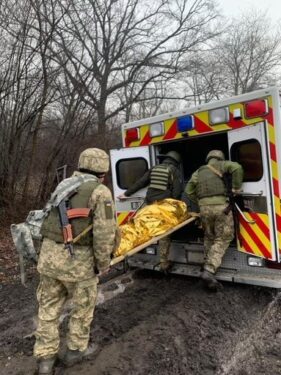Many people in the Chicago area feel connected to those affected by Russian’s invasion of the Ukraine. They’re helping in various ways, and making in impact in one of the most vital areas: health.
5,000 miles — the distance from Chicago to Ukraine. Though geographically distant, many people in the Chicago area feel connected to those affected by Russian’s invasion of Ukraine. They’re helping in various ways, here and overseas, and making in impact in one of the most vital areas: health.
Since the beginning of the conflict in Ukraine, 14 million Ukrainians have been displaced from their homes. More than 8 million of these displaced people have fled the country.
For the refugees seeking permanent resettlement, the Biden administration’s Uniting for Ukraine program set an initial goal of homing 100,000 refugees. In reality, the U.S. has welcomed more than 210,000 Ukrainians since the beginning of the war.
Rising to the challenges
Alisa Roadcup, executive director for Chicago Refugee Coalition, sees the struggles refugees experience when they arrive in the U.S. “Ukrainian refugees face challenges such as lack of access to safe and affordable housing, finding good jobs, language barriers, and especially lack of upward economic mobility for refugee mothers who often have no choice but to remain home as caregivers to their children.” All of these obstacles — along with access to fresh, nutritious food — affect refugees’ overall health.
Getting access to basic necessities such as groceries is no easy task. Something as simple as finding the food to make a familiar meal can go a long way toward making a new country feel like home.
“Newly arrived refugees typically face their greatest economic challenges during the initial 24 months post-arrival, or said another way, during the first two years post-arrival,” Roadcup says. “Resettlement agencies provide support for the first 90 days, but we know that it takes years for refugees to integrate successfully into their communities. Access to fresh and healthy food is a persistent problem.”
Local food pantries are working to fill the need. The West Suburban Community Pantry in Lisle, for example, served 129 Ukrainian households in March 2023. The organization served five Ukrainian households before the start of the conflict.
“It’s heartbreaking to continually see Ukrainian refugees as they leave their home, often leaving family behind,” says Suzanne Armato, CEO of West Suburban Community Pantry. “But we are here to make sure they at least have access to food.”
At the food pantry, volunteers and staff are developing skills to bridge the gap. “Food labels in America are different than in Ukraine, so being able to help our refugee clients understand what is actually in the packages is important,” Armato says. “Plus, there are many new food items our Ukrainian friends are not used to. We do our best to explain how an item might be similar to their traditional food choices.”
Ukrainian refugees often miss their favorite meals, like borscht, a traditional soup with beets, cabbage, and potatoes; or holubtsi, rice- and meat-filled cabbage rolls. Making these foods available to Ukrainian refugees is central to local food pantries’ work.
Armato says the pantry does its best to offer food items such as apples, potatoes, cabbages, and mushrooms that are not only healthy but culturally appropriate for Ukrainian clients, Armato says.
Saving lives back home

A couple of hours south of the food pantry in Lisle, Chris Manson is helping Ukrainians in another unique way — and on their own turf. Manson is vice president of government relations at OSF HealthCare in Peoria. After the Russian invasion in February 2022, Manson created an organization called U.S. Ambulances for Ukraine.
Since its inception, the organization has partnered with fire departments, hospitals, and ambulance companies in 13 states to send vehicles that would otherwise be retired to the battlefront. So far, the group has sent 38 ambulances and six fire engines to the country. Medical supplies fill each vehicle.

“I am so appreciative of the generosity of the American people, the fire departments, ambulance providers, and hospitals and health systems that have contributed to this effort,” Manson said in an OSF HealthCare press release.
The vehicles and supplies go into service immediately, with the ambulances dispatched to military units and the Ministry of Health; the fire engines go to the State Emergency Services. So far, more than 62,000 people have died in the Russian-Ukraine conflict, and at least 59,000 people have endured non-fatal injuries, according to Reuters. Some 15,000 people remain missing.
“Since the beginning, this has been a huge group effort,” Manson said of U.S. Ambulances for Ukraine. “If it wasn’t for the support of OSF HealthCare, the Ukrainian Consulate in Chicago, the Ukrainian Medical Association of North America, and the UA Resistance Foundation, we would have never been able to achieve the success we have had.”
[/vc_column_text][/vc_column][/vc_row][vc_row][vc_column][vc_video link=”https://youtu.be/cEVKdlSIkPU” align=”center”][/vc_column][/vc_row]

Rebecca is an experienced registered dietitian, freelance writer, and yoga teacher who loves to read, hike, and tend her garden.










